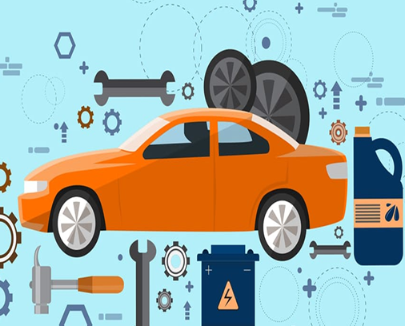Car maintenance tips explained in a clear way. Beginners can follow simple steps to keep their vehicles in good condition.
Why Car Maintenance Matters
Regular maintenance means preventive checkups before your car shows obvious problems. It helps maximize the car’s lifespan and driving safety. Through scheduled maintenance, you not only improve overall performance but also reduce the chance of facing expensive major repairs later. If you already notice something unusual—like your car shaking when you brake—don’t wait until the next service interval or mileage milestone. Take it to the shop right away.
How Often Should You Service Your Car
Since driving habits (how often you drive, how you drive) and external conditions (climate, air quality) vary, basic maintenance usually follows two main indicators: (1) time intervals and (2) mileage—whichever comes first.Exactly when and what type of service is needed depends on the car’s make, model, year, and configuration. Always refer to the car’s owner’s manual as the standard. If you don’t want to flip through the manual, just Google: “(Car year) + (Car make and model) + Maintenance Schedule.”
Still, more auto shops and professionals provide general guidelines for convenience, summarized below:
Every 3,000 – 10,000 miles
Replace engine oil and oil filter
During oil changes, you can also rotate the tires
Check transmission fluid, coolant, power steering fluid, wipers, washer fluid, tires, and all exterior lights
In the past, the rule was every 3,000 miles for an oil change. But with improvements in engine oil quality and engine technology, the frequency is lower. Many manufacturers now recommend oil changes every 5,000, 7,500, or 10,000 miles. Consider driving conditions, vehicle age, and total mileage as well—cars used mainly in city traffic may need more frequent changes.
Every 15,000 – 30,000 miles
At 15,000 miles: replace air filter (more often in dusty environments)
At 20,000 miles: check battery and coolant
At 30,000 miles: replace air filter and power steering fluid; check coolant, radiator hoses, HVAC system, brake pads, and suspension components
Every 35,000 – 50,000 miles
At 35,000 miles: check/replace battery if necessary
At 40,000 miles: replace spark plugs and wires; check ignition system and suspension
At 45,000–50,000 miles: repeat checks above
At 60,000 miles
Replace brake pads and brake fluid. Aside from tires, brake parts are more variable—replacement depends on driving habits and conditions, not just mileage. Watch for shaking during braking, longer stopping distances, or the need to press harder on the brake pedal. If you’ve never had your brakes checked, do it at 60,000 miles.
Replace belts, power steering fluid, coolant, radiator hoses
Check HVAC system, tires, and suspension
Q: What if I skip mileage-based maintenance?
Going a little over usually won’t cause immediate danger—just less smooth driving, higher fuel/electricity use, etc. But delaying too long risks serious issues that affect safety.
Q: What if I can’t remember all these rules?
Simple—read your car’s manual, or follow the two basic types of service:
Regular Basic Maintenance (Minor Service)
Recommended frequency: as per manual mileage or 1–2 times a year
An oil change counts as minor service. Besides oil and filter replacement, the shop usually performs quick checks for safety. If parts need replacing, they’ll inform you (extra cost for parts and labor).
Full Vehicle Safety Inspection (Major Service)
Recommended frequency: based on manual or general mileage milestones
Major service goes beyond minor service: replacing coolant, hydraulic fluids, inspecting brakes, belts, and more. In the U.S., major services often follow these mileage marks:
15,000 miles: basic oil and filter change, tire rotation, plus brake and cooling system check
30,000 miles: everything at 15,000 miles plus vent checks and belt adjustments
45,000 miles: similar to 15,000-mile service; if transmission fluid hasn’t been replaced, do it now
60,000 miles: replace belts, hoses, spark plugs if not yet done
100,000 miles: a full, comprehensive inspection. Many owners return to the dealership for this milestone service
Types of Car Maintenance Items
A classic way to remember is: “Six Lights, Five Fluids, Four Belts, Three Waters, Two Filters, One Air (Tires).”Six Lights
Small lights, headlights, front/rear turn signals, front/rear fog lights, daytime running lights, brake lights.
Five Fluids
Always check for leaks as well as quality:
1. Engine Oil – Basic but critical. Old oil gathers impurities, damaging the engine over time. Fresh oil keeps it smooth, quiet, and fuel-efficient. Options: conventional, semi/fully synthetic, high mileage. Synthetic costs more but offers better protection.
2. Transmission Fluid – Lubricates and cools gearbox parts. Manual and automatic cars use different types. Always follow your manual.
3. Power Steering Fluid – If the steering wheel feels heavy or hard to control, check this. Usually doesn’t need frequent replacement unless contaminated or leaking.
4. Brake Fluid – Can absorb moisture, lowering boiling point. Overheated brake fluid turns to vapor, reducing hydraulic pressure and causing brake failure. Needs periodic checks.
5. Gasoline – Just keep it filled up!
Four Belts
Belts wear over time; replace if cracked or loose:
1. Alternator belt
2. A/C compressor belt
3. Power steering pump belt
4. Timing belt
In English, the first three are grouped as the serpentine (drive) belt, which powers the alternator, A/C compressor, power steering pump, water pump, and air pump. The timing belt synchronizes valves and pistons. If it breaks, the engine may stop suddenly and suffer serious damage. Watch for ticking noises, failure to start, or oil leaks as warning signs.
Three Waters
1. Coolant (Radiator Fluid) – Keeps the engine cool. In snowy regions, antifreeze prevents freezing and corrosion.
2. Windshield Washer Fluid – Tap water works, but some add glass cleaner.
3. Battery Water – Older batteries need it; newer ones are sealed and maintenance-free.
Two Filters
1. Oil Filter – Captures impurities in oil. Always replaced during oil changes.
2. Air Filter (Cabin/Engine) – Like the car’s lungs, filtering dust and particles. Needs more frequent replacement in cities or highways.
One Air (Tires)
Always check tire pressure and tread depth. If worn, replace. Rotate tires regularly to even out wear. If the car drifts to one side, request an alignment.
Other: Spark Plugs
Spark plugs ignite the engine. Worn plugs make starting difficult and reduce efficiency. Copper plugs wear faster; iridium plugs last longer.
Taking care of a car doesn’t have to be complicated. With regular maintenance and timely checks, you can keep your vehicle safe, reliable, and running smoothly for years.





